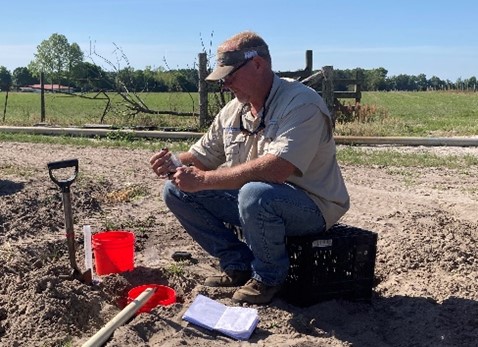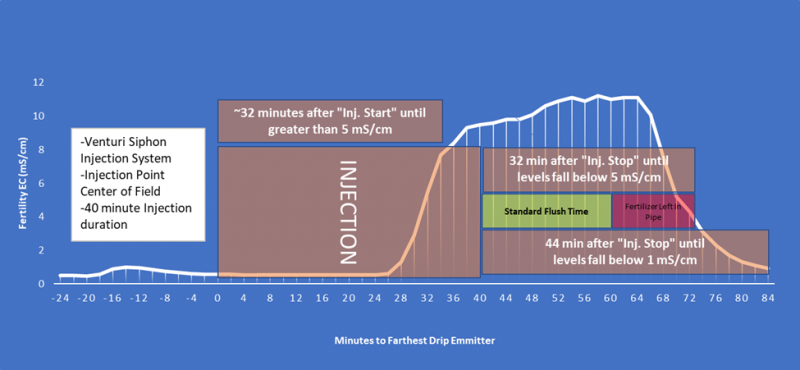UF/IFAS Extension Suwannee Valley Weekly Watermelon Crop Update. Summarized by Bob Hochmuth with input from Suwannee Valley Extension Agents: Mark Warren, Tyler Pittman, Tatiana Sanchez, Luke Harlow, Jay Capasso, Sylvia Wills, Dan Fenneman, Keith Wynn, Danielle Sprague, Kevin Athearn, and Charles Barrett
Note: the 2021 Watermelon Field Day is set for Monday, May 3rd at Watson’s Farm in Levy County (6-7 pm EST)
–
General Crop and Disease Update
–
The crop has continued to be relatively clean and free of major watermelon diseases. All reports last week were pretty similar to the previous 2 weeks in that we all see Fusarium wilt to be very active across the region and many reports of significant plant loss. This year may have the highest levels of infected fields with Fusarium in recent memory, and several are in fields with no recent history of watermelons in these fields. Dr. Nick Dufault will be working with us on collected samples to determine the races of Fusarium common in our fields. There are no research-proven, effective control measures to be implemented against Fusarium at this time of season, although there are several recipes being promoted. My observations on these unproven recipes is “why would there be no University trials to “prove” the effectiveness”? For sure, it seems to me if we had something that we knew worked against Fusarium in the middle of the season, we would certainly want to partner with UF/IFAS to prove it. If no such partnership exists, I would simply ask, …. “why not”? Many of you have heard this commentary for many years and it is not new just to Fusarium cures. I hate to see farmers spend a lot of money if the research is not there to back it up, but, believe me, I also understand the desperation to try something. At the minimum, I would encourage growers trying some of these new recipes to at least leave an untreated area for you (or us) to compare. (Bob Hochmuth).
We are only seeing very isolated cases of any foliar diseases. We have isolated cases of Pseudomonas bacterial leaf spot, Alternaria leaf spot, gummy stem blight, and one possible Anthracnose (not confirmed by the lab yet). These are not widespread at all and, we are not suggesting general sprays across the region.
We still expect to see more foliar diseases this week, so let your county agent know if you see new disease symptoms. Since fields have been pretty much disease free until now, it is a little difficult to know what to spray again this week. But here are the options to consider (same as last week). Continue with Chlorothalonil (Bravo) if fruit is still small, or Manzate plus copper until we see symptoms and guide the spray choices as a result of our findings. The other option is to start a more aggressive preventative approach with Miravis Prime or Inspire Super. Inspire Super is the better choice if gummy stem blight has been present in the field. One of our concerns going into this year is the general reduction of effectiveness of our standby materials for powdery mildew. These have included Torino, Quintec, and Procure, but none of these are “excellent” like they used to be. In some cases, Quintec and Procure had decent activity last year, but both also performed poorly last year in certain fields. Research suggests an even higher level of resistance to Torino. As a result, I think we may choose to get started soon with something like Miravis Prime or Inspire Super and come back with Manzate plus Quintec or Procure. Keep in mind, we are only one month from being in the early harvest season. (Summary by Bob Hochmuth with input from specialists, county agents, and consultants in the field)
Please Hold the Handle Until the Flush is Completed
How long should you flush your drip irrigation system? Many use, what seems like a reasonable rule of thumb, to flush fertilizer from their irrigation systems, but just to better understand we have run a few tests and have found that many may be leaving a significant portion of their fertilizer in the system. Using an EC meter to sense when fertilizer is in the line, we have evaluated several set-ups. In some cases, fertilizer was taking in excess of 40 minutes to reach the farthest point in the field and often in excess of 30 minutes after injection was completed to clear the lines.
–
In at least one case, most of the injected fertilizer was left in the pipe when the standard flush time was completed. Depending on field topography and the potential for leaks in the system, fertilizer left in the line would potentially flow out into the lower parts of the field once the system is shut down. Drip tape flow rates, size and length of mainline, injection methods, and other design features would all influence the results and could be very different between fields.
–
If you would be interested in evaluating a system, contact your local UF/ IFAS Extension Agent. (Mark Warren)
–
Thank You to the Suwannee Valley Rapid Diagnostic Watermelon Program and Its Industry Sponsors
UF/IFAS Extension agents have initiated a more formal way to support our watermelon growers with a rapid diagnostics system through Suwannee Valley Regional. This industry-funded program allows Extension Agents to submit and pay for watermelon grower plant disease and other diagnostic samples. This SV Rapid Diagnostic Watermelon Program will help us to get quicker diagnostic results and not have to charge the growers directly. Plant disease samples are typically $40 and leaf tissue analyses are typically $20. We want to thank the initial sponsors of this program: Syngenta Crop Protection, Harrell’s Fertilizer, Koppert Biological Systems, SEEDWAY LLC, BASF Vegetable Seeds, Bayer Crop Science, Gowan Seed, and Gowan USA for sponsoring this effort. Other industry reps interested in sponsoring this effort can contact Bob Hochmuth at bobhoch@ufl.edu or 386-288-6301.
- 2024 Watermelon Season Wrap Up - June 21, 2024
- Weekly Watermelon Update – June 3 - June 7, 2024
- Weekly Watermelon Update #10 – May 20 - May 24, 2024


